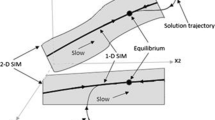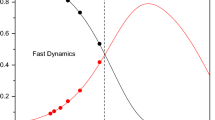Abstract
The Approximate Slow Invariant Manifold method of Singh, Powers and Paolucci is a useful method for addressing model reduction in systems of reactive flow equations. It exploits separations of time scales between slow and fast species, and it generalizes the Intrinsic Low-Dimensional Manifold method, which was developed for model reduction in the context of reaction kinetics, to systems with diffusive and active transport. In this article, we present a mathematical analysis of the Approximate Slow Invariant Manifold method in the context of systems of reaction–diffusion equations with slow and fast reaction kinetics. Beginning with systems of two species (one slow and one fast), and then treating general systems with multiple slow and fast species, we explicitly determine the accuracy of the Approximate Slow Invariant Manifold method. We find that it is correct up to and including the terms of first order in the small parameter that measures the separation of the kinetics time scales, and that it captures many of the terms at second order, as well. Our analysis includes precise statements of the errors at second order, and we find that these are proportional to the slow components of the reaction–diffusion equation, as well as to the curvature of the critical manifold. We illustrate the results analytically on two prototypical examples, the Michaelis–Menten–Henri model with diffusion of the slow species and the Davis–Skodje model in which both the slow and fast species diffuse.
Similar content being viewed by others
References
E. Benoit, M. Brons, M. Desroches, M. Krupa, Extending the zero-derivative principle for slow-fast dynamical systems. Zeit. Angew. Math. Phys. 66, 2255–2270 (2015)
V. Bykov, U. Maas, The extension of the ILDM concept to reaction-diffusion manifolds. Combust. Theor. Model. 11, 839–862 (2007)
M. Davis, Low-dimensional manifolds in reaction–diffusion equations. Part 1. Fundamental aspects. J. Phys. Chem. A 110, 5235–5256 (2006)
M. Davis, Low-dimensional manifolds in reaction-diffusion equations. Part 2. Numerical analysis and method development. J. Phys. Chem. A 110, 5257–5272 (2006)
M.J. Davis, R.T. Skodje, Geometric investigation of low-dimensional manifolds in systems approaching equilibrium. J. Chem. Phys. 111, 859–874 (1999)
L. Edelstein-Keshet, Mathematical Models in Biology (SIAM, Philadelphia, 2005)
N. Fenichel, Geometric singular perturbation theory for ordinary differential equations. J. Differ. Equ. 31, 53–98 (1979)
A.N. Gorban, I.V. Karlin, Thermodynamic parameterization. Phys. A. 190, 393–404 (1992)
A.N. Gorban, I.V. Karlin, Method of invariant manifolds for chemical kinetics. Chem. Eng. Sci. 58, 4751–4768 (2003)
C.W. Gear, T.J. Kaper, I.G. Kevrekidis, A. Zagaris, Projecting to a slow manifold: Singularly perturbed systems and legacy codes. SIAM J. Appl. Dyn. Syst. 4, 711–732 (2005)
A.N. Gorban, I.V. Karlin, AYu. Zinovyev, Invariant grids for reaction kinetics. Phys. A. 333, 106–154 (2004)
A. Goeke, S. Walcher, E. Zerz, Quasi-Steady State - Intuition. Perturbation theory and algorithmic algebra, International workshop on computer algebra in scientific computing, vol. 9301 (Springer, Cham, 2015), pp. 135–151
M. Hadjinicolaou, D.A. Goussis, Asymptotic solution of stiff PDEs with the CSP method: The reaction diffusion equation. SIAM J. Sci. Comput. 20, 781–810 (1998)
F. Heineken, H. Tsuchiya, R. Aris, On the mathematical status of the pseudo-steady-state hypothesis of biochemical kinetics. Math. Biosci. 1, 95–113 (1967)
H.M. Hardin, A. Zagaris, K. Krab, H.V. Westerhoff, Simplified yet highly accurate enzyme kinetics for cases of low substrate concentrations. FEBS J. 276, 5491–5506 (2009)
K.M. Hangos, Engineering model reduction and entropy-based Lyapunov functions in chemical reaction kinetics. Entropy 12(4), 772–797 (2010)
H.G. Kaper, T.J. Kaper, Asymptotic analysis of two reduction methods for systems of the chemical reactions. Physica D. 165, 66–93 (2002)
H.G. Kaper, T.J. Kaper, A. Zagaris, Geometry of the computational singular perturbation method. Math. Model. Nat. Phenom. 10(3), 16–30 (2015)
D. Lebiedz, Entropy-related extremum principles for model reduction of dissipative dynamical systems. Entropy 12, 706–719 (2010)
S.H. Lam, D.A. Goussis, Understanding complex chemical kinetics with computational singular perturbation, In: Proceedings of the 22nd International symposium on combustion, The University of Washington, Seattle, WA, August 14–19, 1988, The Combustion Institute, Pittsburgh, 931–941 (1988)
S.H. Lam, D.A. Goussis, The CSP method for simplifying kinetics. Int. J. Chem. Kinet. 26, 461–486 (1994)
G. Li, A.S. Tomlin, H. Rabitz, Determination of approximate lumping schemes by a singular perturbation method. J. Chem. Phys. 99(5), 3562–3574 (1993)
L. Michaelis, M.L. Menten, Die Kinetik der Invertinwirkung. Biochem. Z. 49, 333–369 (1913)
U. Maas, Coupling of chemical reaction with flow and molecular transport. Appl. Math. 3, 249–266 (1995)
U. Maas, Mathematical modeling of the coupling of chemical kinetics with laminar and turbulent transport processes. In: K.J. Bathe (Ed.) Proceedings of the first MIT conference on computational fluid and solid mechanics, vol. 2, (Elsevier, Amsterdam, 2001), pp. 1304–1308
U. Maas, S.B. Pope, Simplifying chemical kinetics: intrinsic low-dimensional manifolds in composition space. Combust. Flame. 88, 239–264 (1992)
U. Maas, S.B. Pope, Laminar flame calculations using simplified chemical kinetics based on intrinsic low-dimensional manifolds. In: 25th International symposium on combustion, (Combustion Institute, Pittsburgh, 1994), pp. 13–49
J.D. Mengers, J.M. Powers, One-dimensional slow invariant manifolds for fully coupled reaction and micro-scale diffusion. SIAM J. Appl. Dyn. Syst. 12, 560–595 (2013)
B.O. Palsson, Systems Biology: Simulation of Dynamic Network States (Cambridge University Press, Cambridge, 2011)
B.O. Palsson, E.N. Lightfoot, Mathematical modeling of dynamics and control in metabolic networks, I: On Michaelis–Menten kinetics. J. Theoret. Biol. 111, 273–302 (1984)
M.R. Roussel, S.J. Fraser, Geometry of the steady-state approximation: Perturbation and accelerated convergence methods. J. Chem. Phys. 93, 1072–1081 (1990)
V.G. Romanovski, M. Mencinger, B. Fercec, Investigation of center manifolds of three-dimensional systems using computer algebra. Program. Comput. Softw. 39(2), 67–73 (2013)
V.G. Romanovski, D. Shafer, The Center and Cyclicity Problems: A Computational Algebra Approach (Springer, New York, 2009)
M. Stiefenhofer, Quasi-steady-state approximation for chemical reaction networks. J. Math. Biol. 36, 593–609 (1998)
S. Singh, J.M. Powers, S. Paolucci, On slow manifolds of chemically reactive systems. J. Chem. Phys. 117, 1482–1496 (2002)
S. Singh, Y. Rastigejev, S. Paolucci, J.M. Powers, Viscous detonation in \(\text{ H }_2-\text{ O }_2-\text{ Ar } \) using intrinsic low-dimensional manifolds and wavelet adaptive multilevel representation. Combust. Theor. Model. 5, 163–184 (2001)
L.A. Segel, M. Slemrod, The quasi-steady-state assumption: A case study in perturbation. SIAM Rev. 31, 446–477 (1989)
L. Szili, J. Toth, Necessary condition of the turing instability. Phys. Rev. E 48, 183 (1993)
A.M. Turing, The chemical basis of morphogenesis. Phil. Trans. Roy. Soc. Lond. B. 237, 37–72 (1952)
T. Turányi, A.S. Tomlin, M.J. Pilling, On the error of the quasi-steady-state approximation. J. Phys. Chem. 97, 163–172 (1993)
K. Uldall Kristiansen, M. Brons, J. Starke, An iterative method for the approximation of fibers in slow-fast systems. SIAM J. Appl. Dyn. Syst. 13, 861–900 (2014)
S. Vajda, P. Valko, T. Turányi, Principal component analysis of chemical kinetics. Int. J. Chem. Kinet. 17, 55–81 (1985)
B. Yang, S.B. Pope, An investigation of the accuracy of manifold methods and splitting schemes in the computational implementation of combustion chemistry. Combust. Flame. 112, 16–32 (1998)
A.N. Yannacopoulos, A.S. Tomlin, J. Brindley, J.H. Merkin, M.J. Pilling, The use of algebraic sets in the approximation of inertial manifolds and lumping in chemical kinetic system. Physica D. 83, 421–449 (1995)
A. Zagaris, C. Vandekerckhove, C.W. Gear, I.G. Kevrekidis, T.J. Kaper, Stability and stabilization of the constrained runs schemes for equation-free projection to a slow manifold. Dis. Cont. Dyn. Syst. 32, 2759–2803 (2012)
Acknowledgements
The research of X.W. and T.J.K. was partially supported by NSF-DMS 1109587. The authors thank Arjen Doelman for a useful conversation.
Author information
Authors and Affiliations
Corresponding author
Rights and permissions
About this article
Cite this article
Wu, X., Kaper, T.J. Analysis of the approximate slow invariant manifold method for reactive flow equations. J Math Chem 55, 1725–1754 (2017). https://doi.org/10.1007/s10910-017-0756-6
Received:
Accepted:
Published:
Issue Date:
DOI: https://doi.org/10.1007/s10910-017-0756-6




